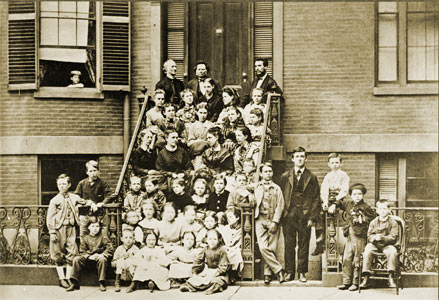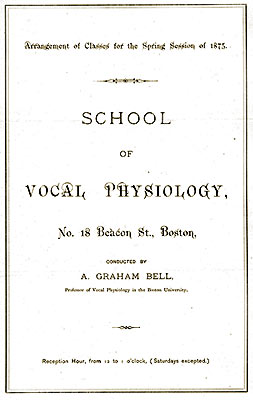 |
His teaching for the deaf |
||||||
1868 - 1876 |
Alexander Bell is initially attracted by the music. It is diverted some however with the profit of studies on phonetics, following the way of his father and probably touched by the problems of deafness from which his mother suffered. His family was associated with the teaching of elocution: his grandfather in London, his uncle in Dublin, and his father, Alexander Melville Bell, in Edinburgh, were all elocutionist teachers. The latter has published a variety of works on the subject, several of which are well known, especially his treatise on Visible Speech, which appeared in Edinburgh in 1868. |
 Bell au 'Pemberton Avenue School' pour les sourds - Boston Library of Congress |
He took advantage of his visit to London to study vocal anatomy at University College London, from 1868 to 1870. |
 |
Bell had charge of the child's entire education for more than three years, 1873-76, living with him at the home of the grandmother in Salem. Further, so remarkable was his teaching of the little Sanders boy that Thomas Sanders in generous gratitude offered to meet all the expenses of his experimenting and of securing patents for his inventions. With Gardiner Greene Hubbard, anotable and an active friend of the education of the deaf, they enter into a formal partnership with Bell. Patent matters would be handled by Hubbard's patent attorney, Anthony Pollok. |
||
During the years 1873-76, Bell was experimenting to invent a device that could translate sound vibrations into visible tracings (like phonautograph - On 25 March 1857, Léon Scott de Martinville received French patent #17,897/31,470 for the phonautograph) He hoped with this instrument he could explain to his deaf pupils how to make their tone-vibrations correctly by comparing visual records of the sounds they made with standard records. Bell never brought his phonautograph to such a stage as to be of practical use for his purpose, but it was of value to him in his telephone experiments; from it he took the conception of the membrane element in the telephone. August-September, 1890, Bell and his supporters form the American Association to Promote the Teaching of Speech to the Deaf. |
| Source : Smithsonian Institution - Fitzgerald Canada - Parks Canada - AT&T - National Geographic Magazine (Vol. XIV, No.6, June 1903) - Alexander Graham Bell National Historic Site - Dictionary of American Biography Base Set. American Council of Learned Societies, 1928-1936. Photos : Library and Archives Canada - Library of Congress American Memory - Smithsonian Institution - National Geographic |
His teaching for the deaf |
||||||